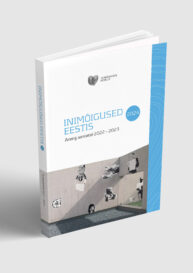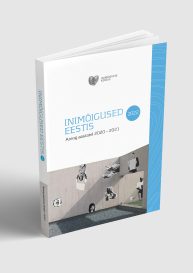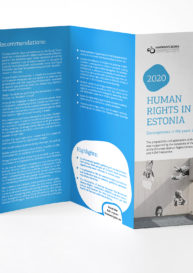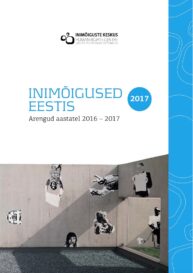Merle Albrant
Discrimination as a topic has been taken up in recent years in Estonia more in media and in Riigikogu. The impression one gets from following discussions on equal treatment is that awareness of essence of discrimination is still low and it is confused with other problems that people have come into contact with. Therefore, it is good to see that the Gender Equality and Equal Treatment Commissioner made several appearances in the media in 2011 as it helps improve people’s awareness of their rights and the ways of protecting them.
Political and institutional developments
Remarkable developments in gender equality in 2011 took place on a political level. Riigikogu passed the decision which proposed the government develop an action plan for reduction of the pay gap between men and women.[1] This decision was passed on 20 May with 77 votes in favour, just three undecided and no votes against it. The statements made by members of Riigikogu during the discussion phase of the proposal, which show a certain increase in awareness (see the text in a box) should definitely also be paid attention to.[2]
Marianne Mikko: “It is without a doubt the obligation of the government to solve the problem of this gaping pay gap between men and women in Estonia. Whether the solution is called an action plan or a strategy, the important thing is that the measures are specific and the results can be measured.”
Rait Maruste: “In order to get a clear overview about how pay gap has come about, its essence and ways to eliminate it, it would be reasonable to raise the level of dealing with the problem from ministerial level to the government’s level and to propose the government prepare an action plan regarding this matter. It would be a political guideline for executive action, which would contribute to a feeling of unity in our society, to equal treatment and to improving Estonia’s international reputation. It is up to the government what kind of steps to take.”
The Gender Equality Act states the obligation to create a Gender Equality Council.[3] Eesti Naisliit (Estonian women’s union) drew attention to the fact that the council had still not been established in 2011 by sending a memorandum to the Chancellor of Justice in regard to failure to completely implement the Gender Equality Act.[4] Eesti Naisliit pointed out that it has repeatedly turned to the Government of the Republic of Estonia and Riigikogu with this issue, but has received no feedback.
The problem of scarcity of resource of the Gender Equality and Equal Treatment Commissioner has not been solved either. The budget of the commissioner for 2011 is made up of 56,248 euros for personnel expenses and 3538 euros for economic expenses, which is not enough for a well-rounded and successful development of the commissioner’s office. There is still no political will to increase the financial assets of the commissioner. Great expectations have been placed on the aid from state of Norway to finance the activities of the next three years.[5] The lack of political will can only be explained by the fact that politicians are not sufficiently aware of the institution of the commissioner, her activities and her impact of the society. This was confirmed by the Minister of Finance Jürgen Ligi at the discussion that took place 26 October 2011 in Riigikogu on the topic of state budget and priorities: “I have not really understood what this man’s, I apologise, this woman’s activities consist of. I do not know what it is she does.”[6]
Legislative developments
Ministry of Justice initiated drawing up of the new Public Service Act in 2011.[7] The draft act went for a coordination round in December. The draft contained some positive examples from the point of view of equal treatment as well as some unsolved questions.
The current act contains no principle of equal treatment, but the draft act of the Public Service Act states it in the general provisions: “The agencies stated in § 5 of this act must guarantee protection from discrimination of persons applying for employment and of officials, and follow the principle of equal treatment as well as promote equality” (§ 11). It remains unclear whether the list of bases for discrimination stated in the Constitution or the lists in specific acts (Gender Equality Act and the Equal Treatment Act)[8] are to be followed. The current Public Services Act states specific traits that cannot be discriminated on upon application (§ 36¹). The draft act has no such provision.
A positive development from the point of view of positive development is the provision that was added in the draft act that regulates the release of an official upon breach of principle of equal treatment.[9] Removal from office in such manner means that the upper limit of compensation is not applicable and a compensation may be demanded that seems most suitable considering the circumstances.
The draft act pays special attention to reduction of inequality upon paying the spousal support. The current Public Service Act provides no support for the non-working spouse accompanying a public servant on business travel abroad, but the draft act does prescribe spousal support.[10] The non-conformity of the current situation to § 12(1) of the Constitution was drawn attention to by the Chancellor of Justice already in the 31 August 2007 address to the Ministry of Justice and the Ministry of Defence.[11] Chancellor of Justice found that business travel as a non-staff public servant based on the Foreign Service Act and a more than six month business trip as an Estonian public servant are comparable from the aspect of travelling with one’s spouse. The draft act builds on that principle. The draft act separately states differences between citizens of Estonia and citizens of the European Union. Citizens of European Union Member States can also be appointed,[12] if they meet the requirements stated in the act and the requirements based on the act (has at least secondary education, has active legal capacity, speaks Estonian in the extent stated in the act or based on the act). The draft act points out cases when unequal treatment of Estonian and European Union citizens upon application for service is justified, if it has a reasonable basis. There is a separate list of posts that only citizens of Republic of Estonia can be appointed (§ 12(2)). These posts have to do with management, state supervision, national defence, exercise of judicial power, state secret, processing of classified foreign information, representation of public prosecution or diplomatic representation of the Republic of Estonia.
Court practice
Two court judgments related to equal treatment and discrimination came into force in 2011.
Supreme Court en banc case no. 3-4-1-12-10 required interpretation of § 12(1) of the Constitution and answers to these questions: for what purposes does § 12(1) of the Constitution allow unequal treatment of persons, what is the relationship of the first and second sentence of § 12(1) of the Constitution, and whether age can be considered to be “other grounds” mentioned in the second sentence of § 12(1) of the Constitution, on which no one shall be discriminated against.[13] Supreme Court also had to decide whether, upon checking the accordance of unequal treatment to the Constitution, the Supreme Court has to, based on § 11 of the Constitution, assess proportionality of the unequal treatment or whether there is an applicable and reasonable cause for unequal treatment. Supreme Court en banc considered unequal treatment based on age to be in breach of the principle of equality stated in § 12(1) of the Constitution, or to be an unequal treatment not mentioned in the provision. Supreme Court en banc declared § 57(6) of the Health Insurance Act to be in breach of the Constitution and void in the part where insured persons of at least 65 years have the right to receive sickness benefit for no more than 90 calendar days a year in total, and in the part where insured persons of at least 65 years have the right to sickness benefit for no more than 60 consecutive calendar days in case of illness or injury.
The Labour Dispute Committee made its first decision in a harassment case, as far as the author knows, on 3 March 2011.[14] In that case the employer taunted and mocked the female employees and didn’t value their family lives and them raising children. The employer also physically assaulted a female employee and shook her with anger. Then again, if the employer was in a good mood, he pinched and hugged the female employees. The Labour Dispute Committee found that the employer had sexually harassed the employee, demanded him to stop the harassment, and awarded 2000 euros in damages in favour of the applicant.
Statistics and surveys
The EU Report on Progress on Equality between Women and Men was published in 2011.[15] The report indicates that the pay gap between men and women in Estonia is the greatest among the EU Member States – 31%, while the EU average is 17.5%. The report also shows that the women are more likely to face poverty as they reach pension age. At-risk-of-poverty rate of Estonian women is 41.3%, while the EU average is 20.1%. This figure for Estonian men is 18.9%, while the EU average is 14.9%. This statistical data clearly points to inequality in the society, which results in lower pay and a greater risk of poverty for women.
European Agency for Safety and Health at Work published a report in February of 2011, which stated that 5–20% of European employees have experienced violence and harassment at workplace.[16] The same report also states that just 8% of Estonian employers see a problem with violence and threat of violence; the EU average is 37%. There is an even greater difference in the opinion of the employees. Just 5% of representatives of employees in Estonia see a problem with violence, while 53% of employees in European Union consider it a problem. The difference there is more than tenfold.[17] The same survey states discrimination as one of top concerns among factors causing psychosocial risks for just 2% of representatives of Estonian employees, while an average of 11% of EU employee representatives consider it a concern.[18]
Discrimination does occur in Estonia and people do fall victim to unequal treatment. This is proved by a relatively high number of discrimination complaints lodged with the commissioner. Already in the interview on 9 November 2011 the commissioner conceded that 288 complaints had been filed in 2011, about 50 of them concerning discrimination.[19]
In 2011 Ülle-Marike Papp and Riina Kütt carried out an analysis on the situation of the LGBT[20] persons in association with the “Diversity Enriches” project of the Human Rights Centre at the Tallinn Technological University. The purpose of the survey was to gain an overview of surveys done on the last ten years of Estonian LBGT community, to chart the problems of LGBT persons and to establish further theses for analysis. The analysis reports that the number of cases based on alleged discrimination on the basis of sexual orientation that have reached the Gender Equality and Equal Treatment Commissioner is still rather small. The number of cases that have been processed is also small (six cases concerned sexual orientation in 2011). It also became apparent that the LGBT persons themselves sorely sense the internalised phobias of the Estonian society as well as of the LGBT community, and the reluctance of all kinds of instances, whether public or the business sector, to deal with the topic.
Good practices
An example of a good practice is the “Diversity enriches” project of the Human Rights Centre at the Tallinn Technical University, which aims to increase the awareness of Estonia’s society about equal treatment and combat intolerance. In 2011 the focus was placed on the fight against homophobia and the advancement of social status of people with disabilities. Several activities were carried out in association with the project in 2011; which is a positive example of how much can be done to increase the awareness of the society:[21]
– An international conference on LGBT topics, which approached the themes of sexual minorities from various aspects, was held in June of 2011.
– Seminars on equal treatment and non-discrimination were held in Tallinn and Tartu in December of 2011. The purpose was to explain the nature of discrimination in theory and in practice, and to provide an overview of legal acts and the opportunities those acts provide.
– A conference on accessibility to the culture of special needs persons was held.
– Two out-door media campaigns were held. The first campaign drew attention to ostracizing of persons with disabilities in Estonian society, and the second one to LGBT topics.
– In order to draw attention to topics of discrimination in the Estonian media in 2011, the larger daily newspapers published annexes on the topics of LGBT and disabled persons.
Another example of a good practice is the training organised by the Estonian Women’s Association Round Table in 2011.[22] Estonian Women’s Association Round Table organised a total of eleven training events for the educational personnel in various regions in Estonia on the topic of advancement of gender equality and prevention of discrimination in education, which was taken part of by 238 participants. Estonian Women’s Association Round Table organised three events on the topic of increasing the gender balance in politics in 2011 with 95 people participating. Four events were held in 2011 by the association on the topic of reduction and elimination of violence against women, which were taken part of by 114 persons. A special mention should be given the eleven day long training aimed at young girls on prevention of violence – empowering trainings, which were taken part of in full by 50 participants.
Essential public discussions
The Gender Equality and Equal Treatment Commissioner became more visible in the media in 2011. She made statements far more often than in previous years and her activities have therefore been given more coverage through various media outlets.
There has been positive and negative media coverage about the commissioner. The commissioner’s activities have been reported on more, as well as when to turn to the commissioner.[23] An example of negative press is the statement of the representative of a religious community, Estonian Evangelical Lutheran Church dean of Saarte deanery, where he demanded the commissioner quit her post as he believed she was abusing her authority and demeaning the citizens.[24] In the author’s opinion, such public statements reflect society’s ignorance of the commissioner’s jurisdiction and of persons’ right to equal treatment. Therefore, it is essential that the commissioner continued to actively work with the media.
Trends
The defining characteristic of 2011 could be the fact that there is still not enough acknowledgment of everybody’s right not to be discriminated against. This was also confirmed by Katrin Kaarma, Director General of the Labour Inspectorate: “The problem in Estonia is that harassment is not acknowledged. What is considered harassment elsewhere in Europe is common behaviour for us.“[25] There are still instances of direct discrimination by the employers already at the point of recruitment, even in advertisements published in newspapers.
Some examples:
- Hiring a single young woman to look after the garden, to clean rooms, as a carer for a person and as a masseuse. Training and accommodation available.[26]
- Shop hiring security personnel from the age of 19.[27]
On the other hand, it can be said that the public has started to discuss the topics of gender equality and equal treatment in 2011, but the general awareness of the society about these topics is still low.
Recommendations
- Increase the opinion leaders’, political decision makers’ and public servants’ awareness of negative effects of discrimination and of the advantages of equal treatment.
- Reach the stage of devising an action plan for reduction of pay gap between men and women at the Parliament of the Republic of Estonia.
- The political parties should define and clearly express their views on questions of non-discrimination and equal treatment.
- The commissioner should continue to actively work with the media for the purpose of increasing the general awareness of the society on discrimination.
[1] Making a proposal to the Government of the Republic of Estonia. 20.09.2011. RT III, 26.09.2011. 06.01.2012.
[2] Riigikogu shorthand notes 20.09.2011. First reading of Riigikogu decision draft act „Ettepaneku tegemine Vabariigi Valitsusele“ [making proposals to the Government of Republic of Estonia] (44OE). Available at: http://www.riigikogu.ee/?op=steno&stcommand=stenogramm&date=1316502300.
[3] RT I 2004, 27, 181 … RT I 2009, 48, 323.
[4] Oviir, Siiri (2011). „Eesti Naisliit otsib soolise võrdõiguslikkuse seaduse rakendamiseks abi õiguskantslerilt“ [Eesti Naisliit seeks help from the Chancellor of Justice in implementing the Gender Equality Act]. Eesti Päevaleht 17.11.2011. Available at: http://www.epl.ee/archive/article.php?id=61779556.
[5] 12th Riigikogu shorthand notes for the 2nd session. 16.11.2011. Rahanduskomisjoni esimehe Sven Sesteri sõnavõtt [speech made by Sven Sester, chairman of the Finance Committee]. Available at: http://www.riigikogu.ee/?op=steno&stcommand=stenogramm&date=1321444800.
[6] 12th Riigikogu shorthand notes for the 2nd session. 26.10.2011. Rahandusminister Jürgen Ligi vastus Marianne Mikko arupärimisele voliniku kantselei rahastamise kohta [Minister of Finance Jürgen Ligi’s reply to interpellation made by Marianne Mikko about financing of the Commissioner’s Office]. Available at: http://www.riigikogu.ee/?op=steno&stcommand=stenogramm&date=1319627100.
[7] Draft act to Public Service Act. 05.12.2011. Available at: http://eelnoud.valitsus.ee/main.
[8] RT I 2008, 56, 315 … RT I, 10.02.2012, 1.
[9] Draft act to Public Service Act § 103(7).
[10] Draft act to Public Service Act § 45(1).
[11] Draft act to Public Service Act 05.12.2011 explanatory memorandum. Available at: http://eelnoud.valitsus.ee/main.
[12] Draft act to Public Service Act § 12(2).
[13] Supreme Court Riigikohus üldkogu. Judgment no. 3-4-1-12-10, (07.03.2011). Available at: http://www.riigikohus.ee/?id=11&tekst=222532575.
[14] Tööinspektsioon (2011). „Eestlane ei teadvusta töövägivalda, kiusamist ja ahistamist“. 07.10.2011. Available at: http://www.ti.ee/index.php?article_id=1923&pages=510&action=article&.
[15] European Commission, DG Justice (2011). Report on Progress on Equality between Women and Men in 2010. The gender balance in business leadership. Available at: ec.europa.eu/social/BlobServlet?docId=6562&langId=en.
[16] Report of European Agency for Safety and Health at Work on new and future risks in European companies ESENER (2010): Eesti Positisioon uuringus [Estonia’s poisition]. 25.11.2010. Available at: http://osh.sm.ee/partnerlusseminar2010.html.
[17] Laas, Maiu (2011). Töövägivald vajab teadvustamist [Violence at work needs to be acknowledged]. 13.10.2011. Available at: http://teinevoimalus.ee/et/paevateemad/310-T%C3%B6%C3%B6v%C3%A4givald-vajab-teadvustamist.
[18] Report of European Agency for Safety and Health at Work.
[19] Krjukov, Aleksander (2011). „Sepper on tänavu tuvastanud kuus diskriminimeerimise juhtu“. [Sepper has already detected six cases of discrimination this year] 09.11.2011. Available at: http://uudised.err.ee/index.php?06238595.
[20] LGBT – lesbian, gay, bisexual and transgender.
[21] Erinevus rikastab. 2011 aasta projekt. [Diversity Enriches. Project of 2011] Available at: http://www.erinevusrikastab.ee/et/projektist/2011-projekt.
[22] Reitlemann, Eha. 14.01.2012.
[23] Krjukov, Aleksander (2011). „Sepper on tänavu tuvastanud kuus diskriminimeerimise juhtu“.
[24] Krjukov, Aleksander (2011). „Saarte praost esindab isiklikku seisukoha“ [Dean of Saarte deanery represents his own personal opinion]. 07.11.2011. Available at: http://uudised.err.ee/index.php?06238453.
[25] Labour Inspectorate (2011). „Eestlane ei teadvusta töövägivalda, kiusamist ja ahistamist“ [Estonians do not acknowledge violence, taunting and harassment at work].
[26] Järva Teataja. 10.09.2011.
[27] CV-online. Tööpakkumised [Job offers]. Available at: http://www.cv.ee/too/tallinna-kaubamaja-as/turvatootajaid-d266206.html?index=4d74df11917e92ddfb54243cebad77e7717f5966.




